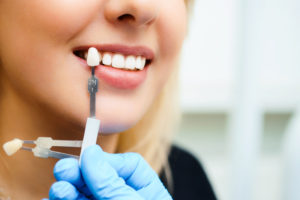
When you think of a dentist, you probably don’t imagine a famous artist like Van Gogh or Michelangelo. However, the truth is that many professionals are drawn to the field of dentistry because it involves a mix of science and art. Restoring a compromised tooth with a dental crown, for example, requires a keen eye that can distinguish subtle differences in color. The end result for you, the patient, is a healthier, more attractive smile! Keep reading below to learn more about what it takes to color-match dental crowns.
Why Teeth Are Different Colors
The color of your teeth can change over time due to several factors. Frequently consuming dark foods and drinks like coffee, red wine, curries, and pasta with red sauce, can cause stains and discoloration. In addition, existing dental work like old fillings or crowns can gradually become discolored as the years pass. Finally, age plays an important role in the color of teeth. As you get older, the outer layer of enamel naturally gets thinner, exposing the yellow dentin underneath. One or more of these reasons could explain why all your teeth are not exactly the same color.
What Is a Dental Shade Guide?
Since teeth can be many different shades, choosing the right color for a dental crown takes both training and the right tools. Many dentists use a shade guide to get the best color-match results. This device is essentially a metal or plastic card that has rows of fake porcelain teeth in a range of hues. During your consultation, your dentist will hold the guide up to your natural tooth and rotate through the fake teeth to find the color that matches your enamel.
Expert Tricks to Find the Perfect Color-Match Results
Even a slight difference in color between teeth, especially front teeth, can be highly noticeable. That’s why some dentists employ these additional color-matching strategies:
- Use Natural Light – Different types of light (e.g., natural, fluorescent, warm, bright, etc.) can affect the way something appears. For the best results, your dentist will likely compare your teeth to their style guide using natural light.
- Controlling Color Contrast – Bright colors can make it difficult for your dentist to judge the shades of your teeth. Therefore, they may place a gray apron over your torso to help them focus.
- Digital Analysis – Some dentists use advanced technology to take detailed photos of adjacent teeth and analyze their color.
As you can see, picking the right shade for your dental crown is more than just science – it’s also a form of art! If you have a damaged or infected tooth, ask your dentist if they can restore it with a perfectly color-matched dental crown.
About the Author
Dr. Jonathan Cohen has completed advanced training in restorative dentistry at prestigious institutes like The Pankey Institute for Advanced Dental Education and The Dawson Center for Advanced Dental Study. He regularly plans and places dental crowns to help protect patients’ teeth. To learn more about the process of color-matching crowns, visit the Julington Creek Family Dentistry website or call 904-230-2961.
